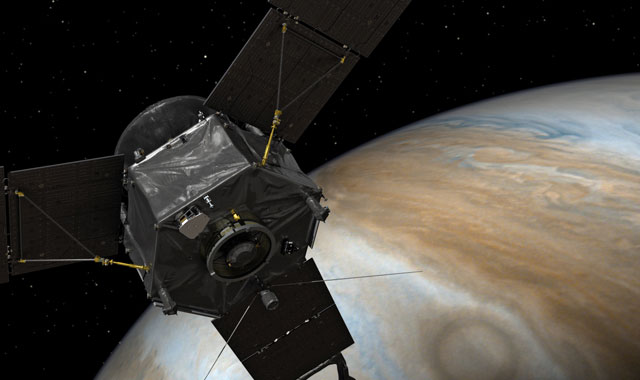
Nasa’s Juno spacecraft has begun to orbit Jupiter to probe the origin of the solar system, the US space agency has said.
The US$1,1bn mission launched five years ago successfully entered the orbit of Jupiter, the largest planet in the solar system, after a 35-minute manoeuvre, Nasa said on Tuesday.
“Success! Engine burn complete. Juno is now orbiting Jupiter, poised to unlock the planet’s secrets,” Nasa said on its Twitter account.
The unmanned solar-powered observatory has traveled 2,7bn kilometers since it was launched five years ago from Cape Canaveral in Florida.
Once in position to begin its 20-month science mission, Juno will fly in egg-shaped orbits, each one lasting 14 days, to peer through the planet’s thick clouds, map its gargantuan magnetic field and probe through the crushing atmosphere for evidence of a dense inner core.
The probe also will hunt for water in Jupiter’s thick atmosphere, a key yardstick for figuring out how far away from the sun the gas giant formed.
Juno will come the closest of any previous spacecraft to the planet, grazing Jupiter’s highest clouds just 5 000km from the surface.
With an atmosphere of hydrogen and helium, Jupiter is known for its Great Red Spot, a storm bigger than Earth that has been raging for hundreds of years.
Heidi Becker, senior engineer on radiation effects at Nasa’s Jet Propulsion Laboratory, described the close approach as going “into the scariest part of the scariest place … part of Jupiter’s radiation environment where nobody has ever been”.
A key concern are radiation levels — as high as 100m X-rays in the course of a year, she explained.
Juno may also encounter debris as it speeds through a belt of dust and meteorites surrounding Jupiter.
“If it gets hit — even by a big piece of dust, even by a small piece of dust — it can do very serious damage,” said Scott Bolton, Juno principal investigator from the Southwest Research Institute in San Antonio, Texas.
Jupiter, the fifth planet from the sun, is believed to be the first planet to have formed in the solar system and likely captured many elements and gases left over from the formation of the star that became the sun.
Researchers hope the mission will provide a window back in time to study the formation of the solar system.
The first mission designed to see beneath Jupiter’s clouds, Juno is named after the Roman goddess who was the wife of Jupiter, the god of the sky in ancient mythology.




